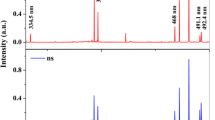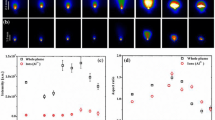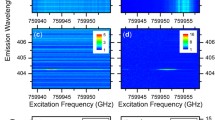Abstract
The dynamic behavior of an ablation plume in low pressure rare gas ambient was investigated with laser-induced fluorescence imaging spectroscopy for three refractory metals, i.e. titanium, zirconium and hafnium. A comparison of the plume expansion behaviors for the species of these elements revealed an atomic weight effect on the plume structure formation. A hemispherical thin layer and cavity structure reported previously for gadolinium were observed also for these elements. It was found that the plume size increases as well as the layer thickness decreases with increasing atomic weight. For ground state atoms of Ti, substantial amount of atoms were observed even at the center of the plume. Also, the persistence of the Ti atomic plume was as long as 300 μs, which was significantly longer than the other species studied. Furthermore, the mass-dependent elemental separation was observed in the ablation plume produced from a multielement sample. These results suggest that the observed plume structure arises from the ion-electron recombination process and the recoil of the ablated species during the multiple collisions with gas atoms.







Similar content being viewed by others
References
D.B. Chrisey, G.K. Hubler (eds.), Pulsed Laser Deposition of Thin Films (Wiley, New York, 1994)
I. Umezu, N. Sakamoto, H. Fukuoka, Y. Yokoyama, K. Nobuzawa, A. Sugimura, Effects of collision between two plumes on plume expansion dynamics during pulsed laser ablation in background gas. Appl. Phys. A 110, 629 (2013)
F. Ullmann, U. Loeschner, L. Hartwig, D. Szczepanski, J. Schille, S. Gronau, T. Knebel, J. Drechsel, R. Ebert, H. Exner, High-speed laser ablation cutting of metal. Proc. SPIE 8603, 860311 (2013)
S.F. Durrant, Laser ablation inductively coupled plasma mass spectrometry: achievements, problems, prospects. J. Anal. At. Spectrom. 14, 1385–1403 (1999)
R.E. Russo, X. Mao, H. Liu, J. Gonzalez, S.S. Mao, Laser ablation in analytical chemistry—a review. Talanta 57, 425–451 (2002)
V.I. Babushok, F.C. DeLucia Jr., J.L. Gottfried, C.A. Munson, A.W. Miziolek, Double pulse laser ablation and plasma: laser induced breakdown spectroscopy signal enhancement. Spectrochim. Acta B 61, 999 (2006)
F.H. Kortenbruck, R. Noll, P. Wintjens, H. Falk, C. Becker, Analysis of heavy metals in soils using laser-induced breakdown spectrometry combined with laser-induced fluorescence. Spectrochim. Acta B 56, 933 (2001)
H.H. Telle, D.C.S. Beddows, G.W. Morris, O. Samek, Sensitive and selective spectrochemical analysis of metallic samples: the combination of laser-induced breakdown spectroscopy and laser-induced fluorescence spectroscopy. Spectrochim. Acta B 56, 947 (2001)
K. Rifai, F. Vidal, M. Chaker, M. Sabsabi, Resonant laser-induced breakdown spectroscopy (RLIBS) analysis of traces through selective excitation of aluminum in aluminum alloys. J. Anal. At. Spectrom. 28, 388 (2013)
O.A. Nassef, H.E. Elsayed-Ali, Spark discharge assisted laser induced breakdown spectroscopy. Spectrochim. Acta B 60, 1564–1572 (2005)
K. Ali, M. Tampo, K. Akaoka, M. Miyabe, I. Wakaida, Enhancement of LIBS emission using antenna-coupled microwave. Opt. Express 21, 29755–29768 (2013)
I.B. Gornushkin, L.A. King, B.W. Smith, N. Omenetto, J.D. Winefordner, Line broadening mechanisms in the low pressure laser-induced plasma. Spectrochim. Acta B 54, 1207–1217 (1992)
H. Liu, A. Quentmeier, K. Niemax, Diode laser absorption measurement of uranium isotope ratios in solid samples using laser ablation. Spectrochim. Acta B 57, 1611–1623 (2002)
B.A. Bushaw, N.C. Anheier Jr., Isotope ratio analysis on micron-sized particles in complex matrices by laser ablation-absorption ratio spectrometry. Spectrochim. Acta B 64, 1259–1265 (2009)
N.R. Taylor, M.C. Phillips, Differential laser absorption spectroscopy of uranium in an atmospheric pressure laser-induced plasma. Opt. Lett. 39, 594–597 (2014)
S.S. Harilal, N.L. LaHaye, M.C. Phillips, Two-dimensional fluorescence spectroscopy of laser-produced plasmas. Opt. Lett. 41, 3547–3550 (2016)
M.C. Phillips, B.E. Brumfield, N.L. LaHaye, S.S. Harilal, K.C. Hartig, I. Jovanovic, Two-dimensional fluorescence spectroscopy of uranium isotopes in femtosecond laser ablation plumes. Sci. Rep. 7, 3784 (2017)
S.S. Harilal, N.L. LaHaye, M.C. Phillips, High-resolution spectroscopy of laser ablation plumes using laser-induced fluorescence. Opt. Express 25, 2312–2326 (2017)
S.S. Harilal, B.E. Brumfield, M.C. Phillip, Standoff analysis of laser-produced plasmas using laser-induced fluorescence. Opt. Lett. 43, 1055–1058 (2018)
J. Bergevin, T.-H. Wu, J. Yeak, B.E. Brumfield, S.S. Harilal, M.C. Phillips, R.J. Jones, Dual-comb spectroscopy of laser-induced plasmas. Nat Commun 9, 1273 (2018)
S.S. Harilal, B.E. Brumfield, N.L. LaHaye, K.C. Hartig, M.C. Phillips, Optical spectroscopy of laser-produced plasmas for standoff isotopic analysis. Appl. Phys. Rev. 5, 021301 (2018)
M. Miyabe, M. Oba, H. Iimura, K. Akaoka, Y. Maruyama, I. Wakaida, Spectroscopy of laser-produced cerium plasma for remote isotope analysis of nuclear fuel. Appl. Phys. A 101, 65–70 (2010)
M. Miyabe, M. Oba, H. Iimura, K. Akaoka, Y. Maruyama, H. Ohba, M. Tampo, I. Wakaida, Doppler-shifted optical absorption characterization of plume-lateral expansion in laser ablation of a cerium target. J. Appl. Phys. 112, 123303 (2012)
M. Miyabe, M. Oba, H. Iimura, K. Akaoka, Y. Maruyama, H. Ohba, M. Tampo, I. Wakaida, Absorption spectroscopy of uranium plasma for remote isotope analysis of next-generation nuclear fuel. Appl. Phys. A 112, 87–92 (2013)
M. Miyabe, M. Oba, H. Iimura, K. Akaoka, A. Khumaeni, M. Kato, I. Wakaida, Ablation plume structure and dynamics in ambient gas observed by laser-induced fluorescence imaging spectroscopy. Spectrochim. Acta B 110, 101 (2015)
M. Miyabe, M. Oba, K. Jung, H. Iimura, K. Akaoka, M. Kato, H. Otobe, A. Khumaeni, I. Wakaida, Laser ablation absorption spectroscopy for isotopic analysis of plutonium: spectroscopic properties and analytical performance. Spectrochim. Acta B 114, 42–51 (2017)
D.B. Geohegan, Fast intensified-CCD photography of YBa2Cu3O7-x laser ablation in vacuum and ambient oxygen. Appl. Phys. Lett. 60, 2732–2734 (1992)
P.J. Skrodzki, N.P. Shah, N. Taylor, K.C. Hartig, N.L. LaHaye, B.E. Brumfield, M.C. Phillips, S.S. Harilal, Significance of ambient conditions in uranium absorption and emission features of laser ablation plasmas. Spectrochim. Acta B 125, 112–119 (2016)
T. Okada, N. Shibamaru, Y. Nakayama, M. Maeda, Investigations of behavior of particles generated from laser-ablated YBa2Cu3O7-x target using laser-induced fluorescence. Appl. Phys. Lett. 60, 941–943 (1992)
Acknowledgements
The present study is financially supported by JSPS KAKENHI Grant Number JP18H01922 and the Nuclear Energy Science & Technology and Human Resource Development Project (through concentrating wisdom) from the Japan Atomic Energy Agency/Collaborative Laboratories for Advanced Decommissioning Science.
Author information
Authors and Affiliations
Corresponding author
Additional information
Publisher's Note
Springer Nature remains neutral with regard to jurisdictional claims in published maps and institutional affiliations.
Rights and permissions
About this article
Cite this article
Miyabe, M., Oba, M., Akaoka, K. et al. Development of laser ablation absorption spectroscopy for nuclear fuel materials: plume expansion behavior for refractory metals observed by laser-induced fluorescence imaging spectroscopy. Appl. Phys. A 126, 213 (2020). https://doi.org/10.1007/s00339-020-3368-0
Received:
Accepted:
Published:
DOI: https://doi.org/10.1007/s00339-020-3368-0




